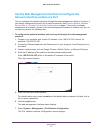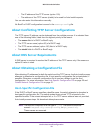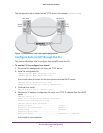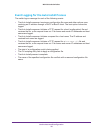
Use the Auto Install Configuration
22
M6100 Series Switches
About Obtaining an Image from a TFTP Server Through
Auto Install
You can use Auto Install to let the switch download an image from a TFTP server using
DHCP option 125. The image update can either upgrade or downgrade the firmware on the
switch.
For the switch to be able to download an image from a TFTP server, the DHCP server must
include an image description file that lists the name of the image that the switch must
download from the TFTP server. For example, the autoinstall_dhcp image description
file on the DHCP server lists the m6100v10.2.0.12 image name that the switch must
download from the TFTP server.
Option 125 in the DHCP server must contain the following information (the example uses the
autoinstall_dhcp image description file and the m6100v10.2.0.12 image name):
• Enterprise number (4 octets). 0x0000 0x1
1ae
In decimals, the enterprise number for NETGEAR is 4526.
• Data Length (1 octet)
. 0x12
The data length includes the SubOption code plus the SubOption length plus the Image
Description File Name: 1+1+16.
- SubOption code (2 octets). 0x05
- SubOption length (1 octet). 0x10
The length of the name of the image description file.
- Image Description File Name (N octets).
61.7574.6f69.6e73.7461.6c6c.5f64.6863.70
In plain text, the name of the image description file is autoinstall_dhcp.
The content of the autoinstall_dhcp image description file is m6100v10.2.0.12.stk,
which is the name of the image that the switch must download from the TFTP server
.
You can change the name for the image description file, but then you must also change the
option 125 Data Length, which is based on the SubOption code, SubOption length, and
Image Description File Name.
Configure Auto Install
The following figure shows an Auto Install configuration with a DHCP server and a TFTP
server, allowing a configuration file to be distributed across a chassis.
The following information is configured on the DHCP or BootP server:
• The IP address (yiaddr) and subnet mask (option1)
• The name of the configuration file (bootfile or option 67)
• The IP address of the
TFTP server (option 150)


















